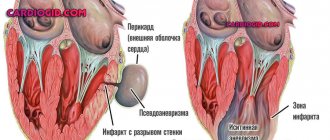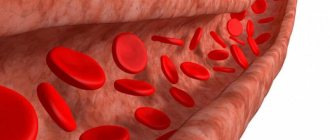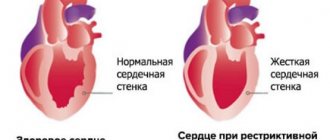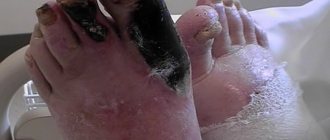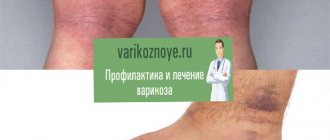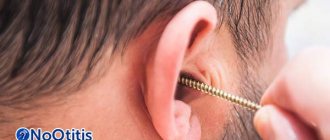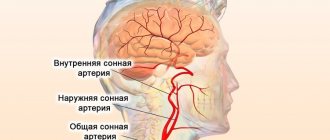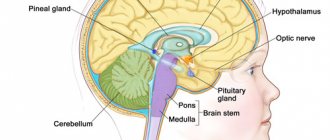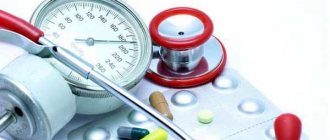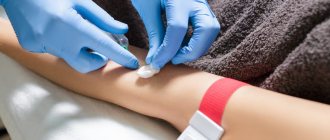Residual encephalopathy is a chronic neurological disease that is accompanied by deficiency phenomena, but to varying degrees, depending on the severity of the lesion that led to such consequences.
This is not an independent diagnosis, it cannot be found in the classifier, there is no ICD-10 code as such, the etiology needs to be refined, we are talking about a generalizing category.
Residual encephalopathy of the brain typically develops as a result of damage to the central nervous system. This is a residual form. For example, it typically appears after a stroke, injury, infection, or other pathologies.
Recovery is carried out according to indications, under the supervision of a neurologist. The forecasts are mostly favorable.
Development mechanism
The process is based on damage to brain tissue. The term “residual” means residual (obtained as a result of another disease).
In total, four main pathogenetic aspects can be distinguished, which form the core of the disorder:
Hypoxic
Most typical for children. Mostly premature. Also those patients who have suffered acute cerebrovascular accidents.
In cerebral structures, cerebral, pronounced ischemic processes begin, preventing the normal nutrition of nervous tissues, which are especially demanding of trophism.
In newborns, the cause may be difficult childbirth, severe pregnancy with intrauterine hypoxia. It is quite possible to achieve compensation in this case, but often there is a pronounced neurological deficit.
Traumatic
As the name suggests, residual encephalopathy (abbreviated RE) is the result of mechanical damage to the nervous system. We are not just talking about typical TBIs, for example, after a blow or a fall.
The same effect is created with the growth of tumors, compression of other brain tissues, and the formation of hematomas.
Recovery involves surgical treatment if necessary.
Infectious
This mechanism is based on damage to cerebral structures by bacterial and viral agents. Meningitis and encephalitis are especially dangerous in this regard.
Both options pose a colossal threat not only to health, but also to life. Treatment outside the hospital is usually not practiced due to high risks.
Diabetic
It manifests itself during the development of the disease of the same name. When it occurs, insulin production or tissue sensitivity to this substance decreases.
The causes are almost always vascular; if the patient is examined, pronounced atherosclerosis and other disorders of the system are discovered.
Therapy is urgent, under the supervision of an endocrinologist and a specialist in nervous disorders.
Other mechanisms are also possible. For example, metabolic. For pathologies not related to diabetes or biochemical. In case of poisoning of the body with its own substances, for example, bilirubin, etc.
The main pathogenetic points are named. The origin of the disease is clarified as part of working with the classifier.
Residual encephalopathy itself is a general diagnosis; it needs to be specified. Division is made precisely on the basis of etiology.
Symptoms and main syndromes of residual encephalopathy
The stage of the disease and the area of brain damage can be diagnosed by the following characteristic symptoms:
At the first stage, residual encephalopathy manifests itself in the form of mild symptoms characteristic of most neurological and vascular diseases. Ignoring the symptoms leads to the fact that the rate of death of brain cells increases and the disease moves to a late stage. The patient experiences significant disturbances in brain activity, resulting in a risk of developing the following syndromes:
- Parkinson's syndrome - due to the massive death of neurons, the patient develops a complex of neurological disorders that cannot be treated.
- Hypertensive syndrome – provokes a significant increase in pressure, both arterial and intracranial.
- Pseudobulbar syndrome - occurs due to the destruction of the nuclei located in the medulla oblongata and disruption of the interaction between them, while brain functions may be partially preserved.
- Epileptic syndrome - manifests itself in the form of sudden attacks of epilepsy.
The last stage of the disease in the absence of treatment and supportive care is the person falling into a coma, followed by death.
Classification
The process is divided according to the nature of the disease. In total, 5 types of changes can be distinguished.
- Hypoxic form. It occurs relatively often, as mentioned earlier. The provocateur is an insufficient amount of oxygen reaching the brain.
This problem is faced by newborns and fetuses in the prenatal period, as well as adults, for example, after exposure to carbon monoxide, attempted suicide by hanging, self-poisoning, intoxication with certain toxic substances, and other processes.
Recovery is possible, but difficult. It is necessary to prescribe medications to reduce the need for oxygen, ensure normal nutrition and cellular respiration.
- Diabetic type. It develops in almost all patients with this diagnosis. The only question is the length of service, the number of years. Without specific treatment and adherence to lifestyle recommendations, the likelihood of a favorable outcome is sharply reduced, as is the timing of the formation of the pathological process.
It is necessary to begin therapy from the very first moments of detection of symptoms. The task of diagnosis falls on the endocrinologist.
- Metabolic form. Not associated with diabetes mellitus; most clinical situations occur due to hormonal pathologies. Hyperthyroidism, with excessive production of specific substances of the thyroid gland, hypercortisolism, when there is too much hormones of the adrenal cortex, etc.
Treatment is etiotropic. Involves eliminating the main provocateur. That is, the primary disease.
- Biochemical form. Occurs when the normal balance of specific substances is disrupted. For example, bilirubin. It is not difficult to identify such an origin of residual encephalopathy. A number of studies are enough.
Therapy is aimed at “correcting” the concentration of a particular substance. And this is often a question that requires treatment of the primary disease. Since an increase in the level of bilirubin is not an independent disorder. But rather the result of disorders of the organs: liver, etc.
- Traumatic form. Changes in normal cellular respiration of brain tissue as a result of injuries.
- Beam type. Occurs when damaged by radiation. Possible for employees on submarines. Also in workers of nuclear power plants, patients receiving therapy for cancer.
This classification is considered the most practice-oriented.
Methods of therapy
Treatment for residual encephalopathy is aimed at eliminating the symptoms of the pathology, improving the patient’s standard of living, and restoring normal functions. For migraines, anti-migraine medications such as Amigrenin and Sumatriptan are prescribed. To get rid of insomnia and stabilize the psycho-emotional state, adaptogens and antidepressants are indicated.
To improve brain activity, neurometabolic stimulants and drugs that increase the metabolism of carbohydrates in brain tissue (Glycine, Mildronate, Phezam, etc.) are prescribed. Diuretics for increased ICP, and for dizziness - Betaserc or its analogues. Hormonal, anticonvulsant drugs, and vitamin complexes may also be prescribed.
Symptoms
The clinic depends on the severity of the lesion, the age of the patient, his general health and other factors.
In children
Residual changes are noticeable almost immediately after birth, provided that a disorder is present.
In some cases, there is no picture at all, even despite, for example, intrauterine hypoxia, since the children’s nervous system is not yet formed.
This is a risk, but on the other hand, it is precisely this feature that gives the central nervous system of young patients colossal adaptability. Therefore, there may be no residual phenomena throughout life.
As for possible symptoms:
- Cry. The child is often capricious for no apparent reason. This state of affairs persists constantly. Parents cannot determine what is becoming the source of discomfort.
- Lack of normal sleep. Unlike adequate situations, although there is rest here, it is extremely superficial. The slightest sound is enough to wake up a newborn. Pronounced fatigue is also noticeable, the child is drowsy, which indicates poor quality rest.
- Frequent regurgitation. Including a fountain.
- Lack of response to stimuli. A child should normally strive to meet his mother’s gaze, maintain non-verbal contact, and smile some time after birth and development.
In this case, the baby tries not to make eye contact, reacts little to touches, words, or there is no such response at all. This is not normal. Although it does not always indicate residual encephalopathy.
- Irritability. Tearfulness, moodiness as a result of attempts to interact. Also intolerance to bright light and sound. Noise, visual and other stimuli. Which is also not an adequate reaction.
- Developmental delay. Variants with speech development disorders, intellectual deficits, problems with attention and other disorders are possible. With proper treatment, it is possible to correct the situation quickly and prevent negative phenomena.
During my teenage years
- Fatigue, weakness, asthenia. The child plays little and strives more and more to rest. There is not enough energy. There is a decline in academic performance at school.
- Mental deficit. Problems with memory, intelligence, cognitive-mnestic abilities.
Caution:
Symptoms are non-specific. It is impossible to say unequivocally that this is a residual brain lesion; autism and many other diseases are possible.
The question is complex, the solution is the prerogative of specialists in neurology and related specialties.
In adults
Here everything is just as difficult, since the clinic is atypical for the condition in question. Possible clinical signs include:
- Severe headaches, migraines. Occur frequently, up to several times a week. In case of severe lesions, they are present almost every day. Localization - occipital region, temples, forehead. It is possible to form sensations on one or both sides at once. Pain is poorly controlled with analgesic drugs.
- Autonomic disorders. Tachycardia. Increased heart rate. The reverse process is also possible. In addition, there is increased sweating, shortness of breath, and weakness. These are phenomena from the nervous system, typical of many diseases.
- Dizziness. Inability to navigate in space. Coordination of movements suffers. The result of insufficient nutrition of the cerebellum. To a lesser extent in other areas.
- Nausea, vomiting. Infrequently. This is an atypical sign, which is why it is quite rare.
- Emotional swings. Increased irritability, aggressiveness for no apparent reason. Other options. Including touchiness, tearfulness. The disease is characterized by an accentuation of negative personality traits.
- Decrease in intelligence. Mental deficit. Accompanied by a decline in memory and other aspects of higher nervous activity.
- Insomnia. At night time. During the day, on the contrary, there is a constant desire to lie down.
Otherwise, the clinic can be divided into four main syndromes:
- Intellectual. Impairments in the speed of thinking, its overall productivity, and concentration.
- Cephalgic. Headache, including migraine, predominates.
- Vestibular. Disorders of spatial orientation and coordination. Unsteadiness of gait, problems with movement.
- Asthenic. Fatigue, drowsiness, decreased performance.
A variant with diffuse neurological symptoms is possible; this is a mixed type of residual encephalopathy. When a group of heterogeneous manifestations of the named syndromes is present. The most common option.
In addition, in severe cases, convulsions are possible.
Attention:
Residual encephalopathy has no tendency to progress. That’s why the clinic is usually stable.
Causes
Some of the provoking factors have already been named. If we talk about them in a little more detail:
- Brain injuries. From bruises to the formation of hematomas.
- Stroke. Acute cerebral circulation disorder with tissue necrosis. Residual foci in this case correspond to the localization of the death of cell accumulations.
- Tumors. Malignant and not. With rapid growth, a mass effect (compression) is created, which is a dangerous factor.
- Infections such as encephalitis or meningitis.
- Metabolic and hormonal disorders. Problems with the pituitary gland, thyroid gland, adrenal glands.
- Diabetes. Associated with it is atherosclerosis.
- Vascular disorders. Thrombosis, previous vasculitis.
- Congenital hypoxia.
- Difficult birth.
- Difficult pregnancy.
- Illiterate actions of obstetricians when a child is born. Including during caesarean section.
There can be several options at the same time.
Diagnostics
The examination is carried out under the supervision of a neurologist. In general, detection does not pose any particular problems in either children or adults.
The basic techniques are:
- Oral interview with the patient or his parents. Complaints need to be identified. And in the case of a child, the main behavioral characteristics.
- Anamnesis collection. Used to qualitatively detect the etiology of a disorder. As a rule, this is where the basis of diagnosis lies. It is necessary to determine whether there have been infections, injuries, strokes, or possibly other disorders in the past. As practice shows, the residual period is not the same period; it can last for years until it manifests itself in a fully clinical picture.
- Electroencephalography. To detect disorders of brain activity.
- Dopplerography of vessels of cerebral structures. Widely used in neurological practice. Provides information about the quality of blood flow in nerve tissues.
- MRI if necessary.
Specific methods are also possible. Including a general blood test, hormone testing, assessment of biochemical parameters and others, as appropriate.
Treatment
Basically, therapy does not differ significantly in patients of different ages.
In children
Medicines of several pharmaceutical groups are prescribed:
- Nootropic drugs. Phenibut, Glycine and others. In order to increase the speed and quality of metabolism in cerebral structures. Used in patients, including younger ones.
- Cerebrovascular. Piracetam and others. To accelerate blood flow in the central nervous system. A necessary condition for recovery.
- In addition, it is possible to prescribe vitamin complexes.
In cases of developmental delay, speech therapy techniques are used.
In adults
There are several more options here. It is possible to use Actovegin, which restores the speed and quality of nutrition, and also reduces the brain's need for oxygen.
In addition, it is possible to prescribe angioprotectors. They protect blood vessels from destruction. Ascorutin, Anavenol and others.
Further, everything depends on what the state of the central nervous system is and what caused the disease.
- It is possible to perform surgery to remove the tumor, eliminate the hematoma, or use antibiotics if the disorder is caused by an infection.
- Metabolic processes are corrected under the control of endocrinologists, as a rule.
- Diabetes is treated by changing the diet and systematically using insulin as needed.
The question is high-quality etiotropic treatment (elimination of the root cause). Relieving symptoms, as well as preventing acute dangerous disorders, is a secondary task. Although both are solved in parallel.
Necessary set of measures
It is no secret that diseases of this degree of danger are difficult to cure using single methods. And even more so, to eliminate residual organic damage to the central nervous system, it is even more necessary to prescribe complex treatment. Even with a combination of several therapy methods, the recovery process will take quite a long time.
To select the correct complex, you must strictly consult your doctor. Typically, the prescribed therapy includes the following set of measures.
Treatment with various medications:
- sedatives;
- psychotropic drugs;
- nootropics;
- antipsychotics;
- vitamins and minerals to improve brain function.
External correction (treatment with external stimulation):
- massage;
- treatment with special loads (kinesitherapy);
- physiotherapy (laser therapy, myostimulation, electrophoresis, etc.);
- reflexology and acupuncture.
Neurocorrection methods
Neurocorrection is a psychological technique that is used to restore impaired and lost functions of the brain.
If there are speech defects or neuropsychic disorders, specialists involve a psychologist or speech therapist in treatment. And in case of manifestation of dementia, it is recommended to seek help from teachers of educational institutions.
In addition, the patient is registered with a neurologist. He must undergo regular examination by the doctor who is treating him. The doctor may prescribe new medications and other therapeutic measures as the need arises. Depending on the severity of the disease, the patient may require constant monitoring by family and friends.
We emphasize that treatment of residual organic damage to the central nervous system during the period of acute manifestation is carried out only in a hospital setting, and only under the supervision of a qualified specialist.
Remember! Timely treatment of organic damage to the central nervous system can stop the development of complications, reduce the consequences of the disease, eliminate symptoms and completely rehabilitate the human nervous system.
Forecast
Mostly favorable. Residual encephalopathy does not tend to progress. Therefore, the symptoms remain at a stable level, almost never getting worse over time.
Except in rare cases, if the underlying disease is still active. Hence the opportunity for quality therapy.
Much depends on the timeliness of treatment, the age of the sufferer, general health, and other important factors, including lifestyle and typical habits. Everything down to nutrition.
Possible consequences
Children experience persistent developmental delays. Mentally, mostly. As for adult patients, decreased ability to work and disability are possible. Recovery is the main way to prevent negative events.
Residual encephalopathy in children and adults is a chronic neurological disease. It is accompanied by disturbances in the functional activity of the central nervous system of varying severity.
With a timely approach, it is possible to compensate for the disorder, or at least smooth it out until there are almost no signs.
And also to achieve the restoration of adequate daily, work, and educational activity. It is important not to delay diagnosis and treatment.
Prevention
Prevention of pathology involves identifying and eliminating factors that can provoke it. It is worth starting preventive measures during pregnancy and in preparation for it. This will prevent the development of congenital encephalopathy and other serious pathologies. Disease prevention is:
- regular examinations, tests, fulfillment of all doctor’s prescriptions during pregnancy;
- timely, complete treatment of viral and infectious diseases;
- preventing head injuries;
- prevention of stress and other negative effects on the psyche;
- strengthening the immune system.
Don’t forget about an active, healthy lifestyle, exercise, and proper nutrition.
With timely diagnosis, the prognosis for patients is often positive. Every fourth person experiences complete relief from the symptoms of the pathology.
